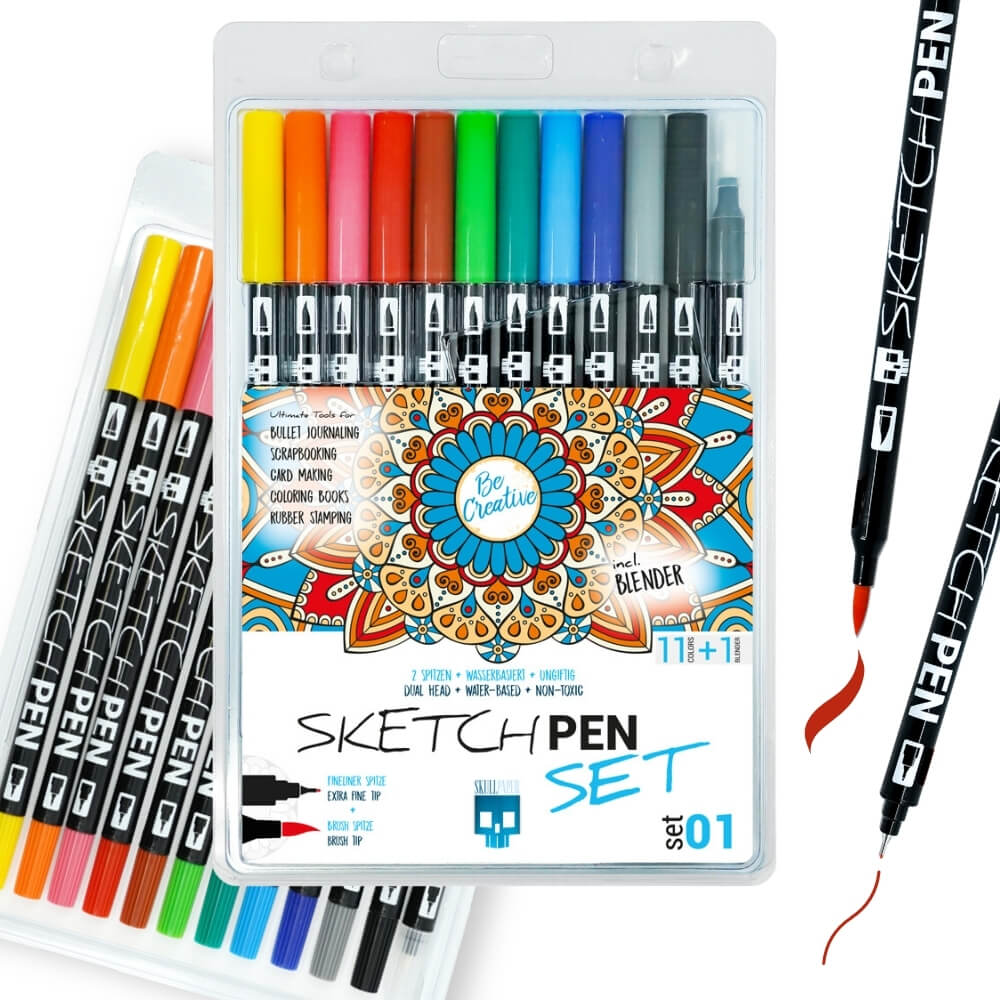Hi Melanie, I'm really happy to have you here. I love scrolling through Instagram and the name "The Vectorians" keeps popping up in connection with our Skullpaper products.
And that made me curious to get to know you a little and find out what you do. Tell us a little about yourself, what you do and what area you come from.
I am very happy about your invitation and the opportunity for this interview. Thank you very much! Yes, I am Melanie, I am originally from the Spreewald and have lived in Dresden since 2005. I worked in a pharmacy for many years, primarily in customer service and marketing. "The Vectorians" is my creative outlet, which I founded with a friend in 2020 during the Corona period, but now run on my own. We created vector graphics, hence the name "The Vectorians", and our main focus was initially the creation of plotter files. Over time, we have expanded our range and optimized the files for laser cutting and engraving work. The aim is to offer creative solutions for various applications, be it for the plotter or laser, for print templates or for combinations with other products.

Does that mean that you are still working in the same field and are doing “The Vectorians” on the side?
Exactly, I'm no longer in the pharmacy, but I still work in the pharmaceutical sector. But since a lot of it revolves around numbers and analysis, "The Vectorians" is my creative outlet and helps me to clear my head. Working with my hands in particular is sometimes very relaxing.

You mentioned vector graphics and plotting earlier. Is plotting your specialty at The Vectorians?
Exactly, that's the main point. The creation of the files is actually the main focus. You can use the files in different ways, and I try to show that in the social media area too. You are not just limited to plotting. The files can be used for many other creative projects, e.g. printed on waterslide film or sticker paper, plotted with film or lasered from wood or other materials. By using them individually, you can work with different workpieces and are not just limited to the plotter.


For someone who has never heard of it... Please briefly describe what a plotter actually is? What do you do with it?
When many people hear the term “plotter”, they think of the large printers that are used in architectural offices for technical drawings. However, there are also plotters for hobbyists. These have a small cutting knife that cuts the contours of a motif, i.e. the outer lines. Instead of the knife, you can also use a pen and draw like with a “large plotter”. However, different types of foil or paper are usually used for cutting. After cutting, the material that is not needed is removed. With foil, this is called “weeding”. The motif can then be transferred to a textile or other surface. Many people are familiar with such motifs or lettering on football shirts that are covered with flock foil, or on car lettering that is covered with vinyl foil. In fact, all of this is done with a plotter.

At “The Vectorians” you sell files for downloading. Among other things, for plotting. What kind of files are most in demand and what do people do with them?
I don't see what people end up using it for. I only see which files are bought, but often not how they are implemented. If someone links to me on social media, I can see what was ultimately created from it, but otherwise it often remains a mystery. As I said, there are an incredible number of design options. When it comes to plotting alone, the options are endless thanks to the choice of different films and colors. But I do think that there are still more people with a plotter than with a laser, and even more with just a printer.
People with plotters often use heat transfer films for their projects because they are easier to handle than vinyl films. When working with vinyl films, you have to be a bit more skilled and pay attention to a few things when removing the weed so that you don't end up peeling everything off at once. Beginners in particular are hesitant to try this. Simple projects with heat transfer films are more popular because they are easier to implement. These are often the first projects that beginners dare to tackle.

To come back to beginners... I saw that you wrote on your website that you weren't confident about working with it at the beginning. What were you afraid of and what helped you progress? What would be your best tips for learning plotting if I'm a beginner?
So, I got my first plotter in 2015. It sat unused for three or four months because I didn't know how to get started. At the time, there was only one book, but it wasn't very detailed, and there were hardly any videos on the internet. So I just tested and tried things out: How does the film work, how do you cut? My first plotter was from Silhouette, and I had to set the blade depth manually. That took a lot of attempts and a lot of material wastage, but I also learned a lot. Today, the cutting settings are often set automatically and you just have to enter the material.
I would recommend beginners start with simple projects using heat transfer foil, such as a small heart or circle, to get a feel for cutting and weeding. There are now many videos and tutorials online that explain step by step how to do it. Material knowledge is also important; it's best to try out different materials to see how they behave.
Another tip is to use the right tools. At the beginning I weeded with a small needle and then I quickly got cramps in my hand. But there are special weeding hooks that are very helpful. When working with vinyl, I recommend negative weeding: the carrier film is applied to the entire film before you start weeding. This is particularly helpful with delicate motifs.
Good light is also important so that you can see the cutting lines clearly.

You briefly mentioned the topic of books. Is there a particular book that helped you particularly?
I can't recommend a specific book. Most start with the basics, such as tools and materials, and then move on to different projects. I always think it's nice when the book gives you access to different practice files. Back then - before "The Vectorians" - I had a book by Paul and Clara, which was visually very appealing and contained some great projects that you could download straight away.
There are now many other beautiful books by great designers, often with a large file package for practicing and getting creative. I also contributed to one book myself. A few designers and I contributed practice files. The book is called “The Great Plotter Lexicon - Practical Guide” and can be found on Amazon. As the name suggests, it is a practical guide for getting started in the world of plotting. There are many different projects and you can try out all the materials.

If you look five years into the future, where would you like to go with “The Vectorians”? What is your goal?
Life means change and I think the creative business will also change a little bit. For me that means adapting to the wishes and needs of the market and constantly developing new ideas and creating incentives. I don't know what will happen in 5 years. Everything comes in its own time and for me "The Vectorians" is a journey and a baby that is allowed to develop. In any case, I am excited to see where my journey takes me.
In any case, in the future I will also offer a selection of ready-made products to appeal to those who don't have a plotter or laser. I will also be moving more towards personalization. The market for plotter files is now so large, and there are many free files, which makes it difficult for us designers. And constantly coming up with something new is a challenge.

You also have a website where I can buy the files. What is the best way for your customers - or someone who wants to find out more about you - to find you?
Well, mainly via my website www.thevectorians.de . Then of course on social media channels like Instagram and Facebook. These are the two main platforms that I use to present my files and to give ideas for applications. But you can also find me on TikTok and Pinterest, even if these channels are not used quite as extensively.
I also have a WhatsApp catalog that is also linked via Instagram. This gives you a direct line to me.

You said that you want to focus more on individual things in the future. That means I come to you and you help me implement the idea I have in mind. Do I understand that correctly?
Exactly, if you want personalization, for example, I can prepare the file for you so that you can process it yourself. If you don't have the opportunity to plot or laser it yourself, I could do that for you.

Melanie, thank you very much for your time and the insights into your work and your business and all the best with all your projects.
Thank you for the opportunity to present my work here!
MORE ABOUT MELANIE:
WEB
TikTok
Photos: ©Melanie Helms












